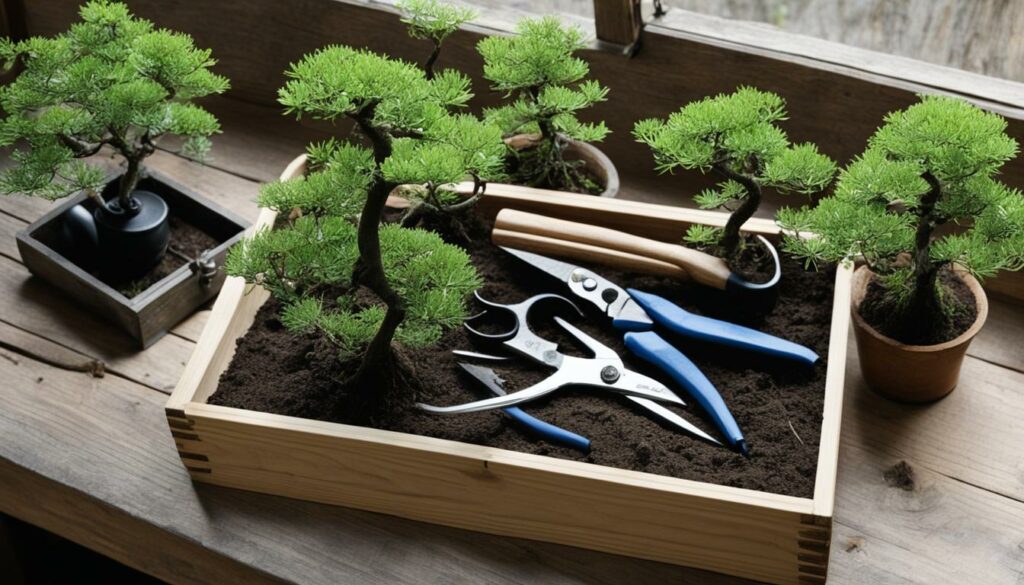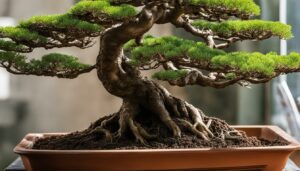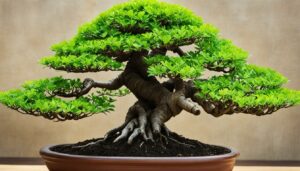Embarking on the meticulous journey of Bonsai cultivation requires more than just a green thumb—it demands precision, patience, and the right set of tools. Whether you’re a seasoned arborist or a fledgling enthusiast, mastering Bonsai care is a delicate art that hinges on using the appropriate basic Bonsai tools. From shaping the miniature landscapes to ensuring the longevity of these living sculptures, every snip, water, and repot contributes to the creation of a Bonsai masterpiece.
Investing in quality Bonsai equipment and committing to regular tool maintenance lays the foundation for a thriving Bonsai portfolio. As you cultivate your skills and deepen your understanding, you’ll appreciate how each tool is designed to mirror the attentiveness you pour into your Bonsai practice. Let’s explore the indispensable tools that will shape your journey from the roots up.
Key Takeaways
- Selecting the right basic Bonsai tools is crucial for precision in Bonsai care.
- Quality Bonsai equipment is an investment that pays off in the health and beauty of your trees.
- Regular maintenance of Bonsai tools ensures their longevity and effectiveness.
- Each Bonsai tool is designed for a specific purpose, from pruning to potting.
- Effective Bonsai care relies on both skillful hands and the right set of tools.
Understanding Bonsai: The Art and Science
The practice of Bonsai cultivation stands at the intersection of artistic mastery and botanical science. A dance of discipline and creativity, the journey into Bonsai begins with a deep appreciation for the meticulous care these miniature trees demand.
What Is Bonsai?
The term Bonsai translates to ‘planted in a container.’ This intricate art form is steeped in history, originating over a thousand years ago. It goes beyond merely growing a tree in a pot; Bonsai involves meticulous techniques that create a harmonious and scaled-down representation of nature. The art of Bonsai calls for vision and patience, aspiring to evoke the essence of a natural landscape within a confined space.
The Importance of Proper Bonsai Equipment
To cultivate a Bonsai is to engage with both the art and science of Bonsai, requiring an array of specialized tools. Just as a painter requires brushes and a sculptor needs chisels, the Bonsai enthusiast relies on a suite of equipment designed to execute tasks with precision and care. These instruments facilitate everything from pruning to wiring, ensuring each step in the cultivation process respects the tradition’s authenticity and attention to detail.
| Tool Type | Purpose | Significance in Bonsai |
|---|---|---|
| Pruning Shears | Trimming and shaping | Creates form and structure |
| Bonsai Wire Cutters | Cutting wires without damaging branches | Essential for shaping and training |
| Root Rakes | Untangling roots during repotting | Promotes a healthy root system |
| Soil Scoops | Transporting and measuring soil | Ensures precise soil management |
Basic Bonsai Tools: Your Starter Kit
Embarking on the practice of bonsai requires the right set of tools to ensure that your miniature trees grow healthily and maintain their artistic form. A bonsai starter kit typically includes a variety of pruning tools and other essential care instruments to help both novices and experienced enthusiasts execute precise maintenance tasks.
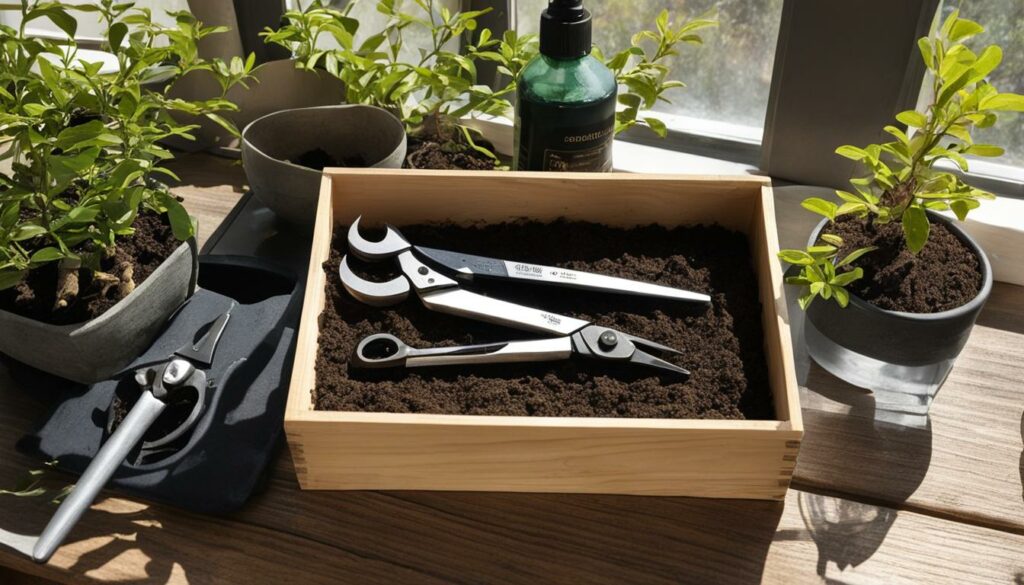
Selecting the Right Pruning Tools
Pruning is a fundamental technique in bonsai care, and using quality pruning tools makes a significant difference. When selecting these tools, look for ones designed specifically for bonsai maintenance, as they are finely crafted to handle the delicate branches and roots. Here are the must-haves for your toolkit:
- Concave Cutters: Ideal for removing branches cleanly without leaving unsightly stubs, these create a slight indented cut that heals with minimal scarring.
- Bonsai Shears: Sharp and precise shears are indispensable for trimming foliage and smaller branches to refine your tree’s silhouette.
- Wire Cutters: Specifically used for cutting wires without damaging the bark, bonsai wire cutters are essential when shaping and training your tree.
Essential Care Tools for Maintenance
Maintenance goes beyond cutting and shaping; your bonsai also needs regular care in terms of soil management, watering, and nutrition. Equip your maintenance kit with:
- Soil Scoops: These tools allow you to replace or add soil around your bonsai without creating a mess, ensuring that every grain is placed thoughtfully.
- Watering Cans: A small, long-spout watering can give you control over hydration, allowing for gentle watering that does not disrupt the soil or delicate plants.
- Fertilizers: The right blend of fertilizers is key for bonsai health. Whether you’re using a solid or liquid variant, ensure it’s formulated for bonsai to provide the necessary nutrients.
The Role of Pruning in Bonsai Care
Pruning is not merely a means of shaping your Bonsai; it’s a vital practice for controlling growth and maintaining the miniature tree’s health. Bonsai pruning techniques are about more than aesthetics; they influence the plant’s growth patterns and long-term vigor. By understanding when and how to prune, you ensure not only a Bonsai that pleases the eye but one that also stands the test of time.
Pruning for growth control involves two main approaches: maintenance pruning, which ensures the Bonsai retains its shape and style, and structural pruning, which involves more significant cuts to influence the tree’s future growth direction and structural integrity.
- Maintenance Pruning: Regularly removing small amounts of growth to clean up the silhouette.
- Structural Pruning: Occurs less frequently, targeting branches that disrupt the Bonsai’s overall design.
Successful pruning is as much about the timing as it is about the technique. For most Bonsai trees, the best time to prune is when they are actively growing. Deciduous trees, for example, are often pruned in early spring, ahead of the growth surge.
| Tree Type | Best Pruning Season | Pruning Objective |
|---|---|---|
| Deciduous | Early Spring | Structural shaping before leaf-out |
| Coniferous | Mid-Summer | Control growth after spring surge |
| Tropical | Anytime during active growth | Maintenance for continual shape |
To practice pruning for growth control, start by identifying unwanted elements: crossing branches, those growing inward towards the trunk, or any that disrupt the Bonsai’s balance. The strategic removal of these elements encourages the tree to direct its energy towards the development of a desirable form.
Remember, good pruning is the cornerstone of great Bonsai. It not only defines your tree’s miniature landscape but also empowers you to cultivate its future health and beauty.
Choosing the Best Soil Tools for Repotting
As you embrace the rewarding practice of repotting bonsai, you’ll quickly realize the significant role that specialized Bonsai soil tools play. These instruments are not merely for convenience; they ensure the health and structure of your bonsai are maintained during the delicate repotting process.
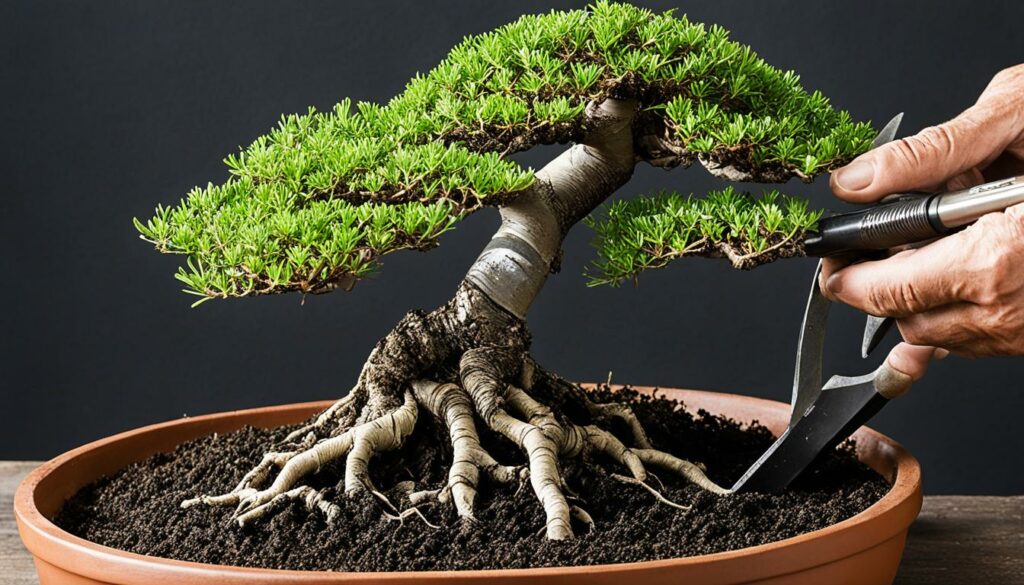
The Essentials: Scoops and Sieves
When it comes to laying a solid foundation for your bonsai, the tools you use to handle the soil can make all the difference. Proper scoops are necessary for transferring soil without creating unnecessary mess or waste. Sieves, on the other hand, are essential for sifting out fine particles and aerating your substrate. This aerated soil promotes better water distribution and root growth, a fundamental aspect for a thriving bonsai. Here’s a breakdown of why each tool is indispensable for repotting bonsai:
- Scoops: Allow for precise soil placement and prevent soil compaction that can damage fine roots.
- Sieves: Ensure uniform soil texture; remove large particles to facilitate optimum root penetration and water retention.
Understanding Soil Tamper and Root Rakes
The right execution of repotting includes not just changing the soil but ensuring it is set correctly around the bonsai’s roots. For this, a soil tamper helps in evenly compacting soil around the roots, eliminating air pockets which can dry out roots and destabilize your bonsai. Root rakes are employed to gently detangle and spread the roots, encouraging them to grow outwards into the fresh soil. Balancing firmness with delicacy, these tools are instrumental for the health and stability of your bonsai post-repotting.
| Tool | Function | Benefits |
|---|---|---|
| Soil Tamper | Compacts and evens out soil | Reduces air pockets, supports stable root growth |
| Root Rake | Detangles and spreads roots | Promotes even distribution and healthy root expansion |
With these essentials – from scoops and sieves to tampers and rakes – your repotting process can be as nurturing as it is necessary. Investing in the right Bonsai soil tools is not merely a choice but a commitment to the art and wellbeing of your miniature tree-scape.
Watering Bonsai: Tools for Proper Hydration
Mastering the art of Bonsai hydration is more than just routine watering. It’s about understanding the subtle needs of your miniature trees and responding with precision. In this section, we explore the specialized Bonsai watering tools designed for this purpose, alongside advanced devices like moisture meters and hygrometers that help in monitoring moisture levels, ensuring your Bonsai thrives in its environment.
The Importance of Watering Cans and Misters
Choosing the right tool for watering can make a significant difference in the health of your Bonsai. A high-quality watering can with a fine rose attachment provides a gentle shower that doesn’t disturb the soil or damage the foliage. Meanwhile, misters are perfect for keeping the humidity levels optimal, especially for tropical Bonsai species that crave a moist environment. These tools not only aid in effectively hydrating your Bonsai but also in preventing the diseases that are common in stagnant conditions.
Monitoring Tools: Moisture Meters and Hygrometers
When it comes to caring for Bonsai, vigilance is key. Over-watering and under-watering are the main culprits behind many Bonsai health issues. That’s where moisture meters come into play. By inserting these handy devices into the soil, you can receive an accurate reading of the moisture content, eliminating the guesswork involved in daily watering routines. Similarly, hygrometers measure the relative humidity around your Bonsai, ensuring that you can maintain the perfect microclimate for your plant’s wellbeing. Together, these monitoring tools are essential for perfecting the delicate balance of moisture needed for a healthy Bonsai.
- Watering cans: Essential for controlled, gentle watering.
- Misters: Ideal for maintaining a humid environment.
- Moisture meters: Provide precise soil moisture readings.
- Hygrometers: Measure surrounding humidity, essential for tropical varieties.
Investing in quality Bonsai watering tools and diligently tracking the humidity and soil moisture with meters and hygrometers will set you on the path to successful Bonsai cultivation. Remember, the right tools not only simplify your work but also ensure the flourishing beauty of your Bonsai for years to come.
Wiring Techniques: Shaping Your Bonsai
Mastering Bonsai shaping is akin to embracing a form of living sculpture, where the medium is the ever-changing growth of a tree. One of the most critical skills in a Bonsai enthusiast’s arsenal involves understanding and applying various wiring techniques to guide this growth. The use of Bonsai training wires is a delicate dance between the artist’s intent and nature’s will, creating harmony within your miniature landscape.
As you embark on the journey of wiring your Bonsai, your approach must be one of patience and gentleness. The act of wrapping branches with wire—and bending them into the aspirational form—can stress your living artwork. To avoid any harm to your Bonsai, it’s fundamental to learn how to choose the correct gauge and type of wire. Most commonly, enthusiasts use anodized aluminum or copper wires due to their flexibility and strength.
Aluminum wires are often recommended for beginners because they are easier to manipulate, especially on softer trees. On the other hand, copper wires offer greater holding power, making them suitable for species with stiffer wood.
Bonsai artists employ two primary wiring techniques:
- Single Wiring: where individual branches are shaped using one piece of wire.
- Double Wiring: where two branches of similar thickness are shaped using one wire, providing added stability and uniformity.
The nuanced act of wiring is not a ‘set-and-forget’ affair. Regular monitoring is essential to prevent the wires from cutting into the growing bark, which can leave scars or constrict growth. Depending on the growth rate of your Bonsai, wires typically stay on for a few months up to a year. The key is to never rush the process; appreciate the gradual evolution of your Bonsai’s form as it is sculpted by your hands and wires.
The practice of Bonsai shaping with wires is more than just achieving aesthetic appeal. It’s about imparting strength and character to your tree, allowing it to embody the essence of Bonsai. Apply these wiring techniques mindfully, and watch as your Bonsai transforms into a living testament to your care and creativity.
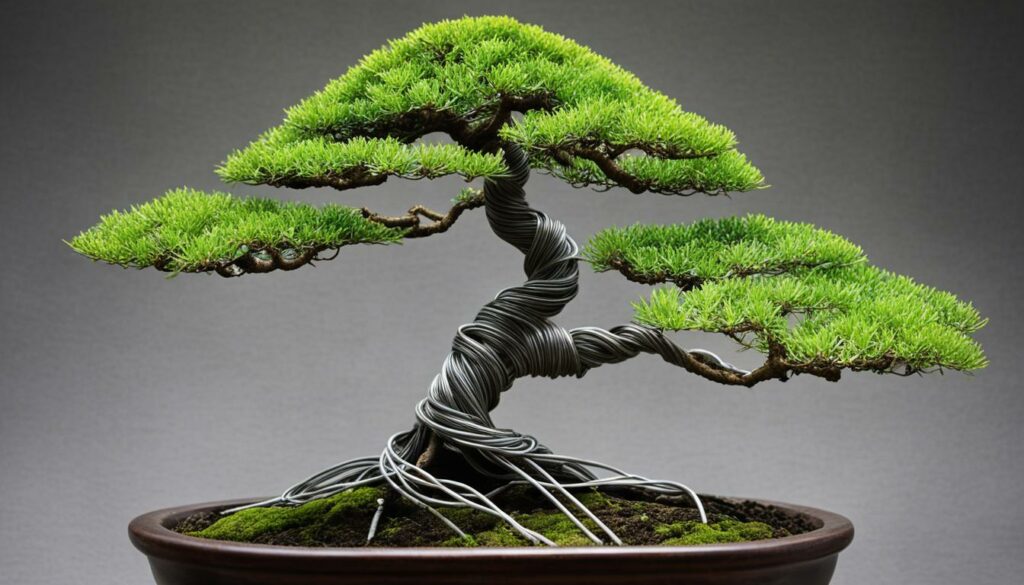
Potting and Repotting: Containers and Accessories
Embarking on the journey of potting or repotting a Bonsai tree starts with choosing the right Bonsai pot and gathering necessary repotting tools. The selection of Bonsai containers should be approached with care as they are not only foundational to the health of your Bonsai but also contribute significantly to its overall aesthetic. Let’s delve into what makes an ideal Bonsai pot and examine the essential tools required for the repotting process.
Choosing the Right Bonsai Pots
When selecting Bonsai pots, consider the following factors:
- Size: The pot should be large enough to accommodate the root system without crowding but not so large that the soil stays wet and causes root rot.
- Shape and Style: The container shape should complement the style of your Bonsai. Balance is key— a pot that’s too ornate may overshadow the tree, while one too plain could underwhelm.
- Material: Bonsai pots are made from a variety of materials, each with its pros and cons. Clay and ceramic pots offer breathability and aesthetic appeal, while plastic or resin pots are lighter and often more affordable.
Tools for Repotting: Brushes and Spades
The proper repotting tools are indispensable to successfully transition a Bonsai into a new container:
- Brushes: These are used to gently clean old soil from the roots and the interior of the container, ensuring that the Bonsai’s delicate root system is not harmed during the process.
- Spades: These help in the delicate movement of soil and in placing the Bonsai within the pot. A good spade can mean the difference between a smooth repotting experience and potential damage to the tree.
Here’s a comprehensive list of the tools you’ll need for efficient repotting:
| Tool | Purpose | Usage Tip |
|---|---|---|
| Root Rake | To untangle roots and remove soil | Use gently to avoid damaging roots |
| Soil Scoop | For adding and removing soil | Choose one with a funnel spout for precision |
| Bonsai Shears | For pruning roots before repotting | Keep sharp for clean cuts that promote healing |
| Chopstick or Wooden Stick | To settle soil around roots and remove air pockets | Use a smooth, non-splintered stick to preserve roots |
| Wire Cutters | To remove or adjust wires securing the tree | Opt for cutters specifically designed for Bonsai for better control |
| Tweezers | To remove debris and dead leaves | Long, narrow tweezers can reach into tight spaces without disturbing the setup |
Equipping yourself with the right Bonsai containers and repotting tools can greatly influence the health and beauty of your Bonsai. Always be meticulous in your preparation, and your Bonsai will thrive in its new home.
Feeding Your Bonsai: Fertilization Tools
Bonsai fertilization is a crucial component of feeding Bonsai to ensure their health and vitality. Understanding the types of fertilizer and the tools needed for application can make all the difference in nurturing a thriving Bonsai. Whether you’re reaching for solid or liquid nutrients, each method requires specific fertilizer tools for effective use.
For solid fertilizers, tools such as fertilizer baskets or holders enable a slow release of nutrients into the soil, which is ideal for Bonsai’s gradual feeding needs. These holders help to keep the fertilizer in place and allow for the easy measurement of portions.
Liquid fertilizers are favored for their ease of use and quick absorption. However, they’ll require the use of a watering can or a dosing spoon to ensure the right amount is applied and evenly distributed across the soil to prevent root burn and over-fertilization.
Regardless of the type of fertilizer you choose, it’s vital to have a clear feeding schedule. Bonsai need more nutrients during their growth season, typically spring and summer. As for the amount and concentration, it’s imperative to follow the instructions provided by the fertilizer manufacturer to avoid damaging your precious Bonsai.
- Use fertilizer baskets for controlled solid fertilizer application.
- Dose liquid fertilizers with special tools to ensure even distribution.
- Adjust the feeding schedule based on the season and the tree’s growth cycle.
An essential consideration in fertilization is the use of fertilizer tools that facilitate precise application. Accurate feeding will contribute to the lush foliage and robust growth that make Bonsai so captivating.
When applying these practices and using the appropriate tools, you will embark on a journey that not only preserves the beauty of your Bonsai but enhances it.
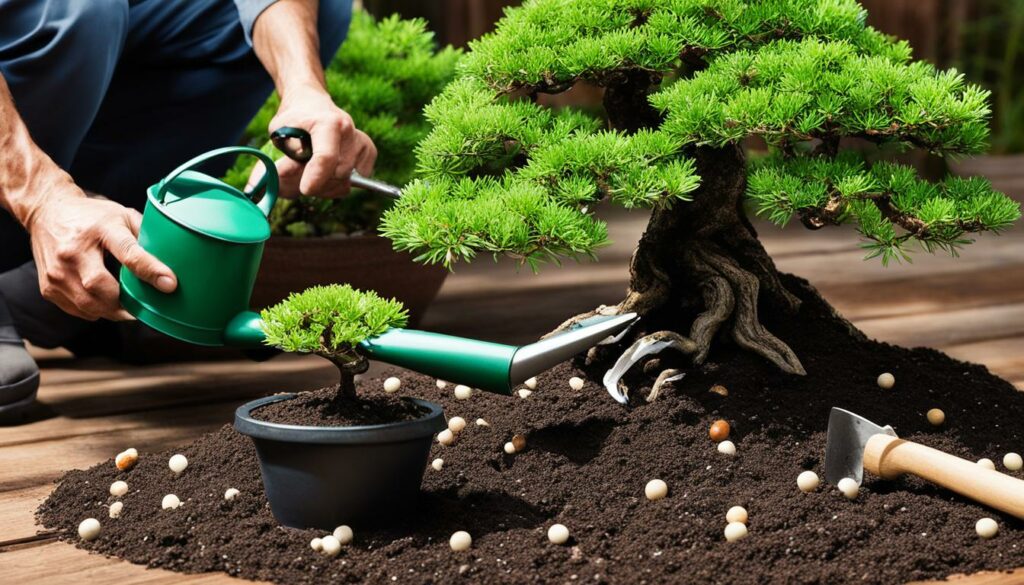
Maintenance and Care: Keeping Tools in Top Condition
Cultivating Bonsai is a practice that relies heavily on precision and attention to detail. To achieve that meticulous care, your Bonsai tools must be in pristine condition. Proper Bonsai tool maintenance is not just about preserving the functionality of the tools; it’s about respecting the art form. Caring for Bonsai tools regularly guards against wear and deterioration, ensuring each cut and adjustment you make is clean and precise. Here’s how you manage to keep your tools preserved for the long term.
After each use, cleaning your tools is imperative. Sap and residue can corrode the metal and dull the blades, compromising their efficiency. Rinse them with water and use a mild detergent if necessary. Dry them thoroughly to prevent rust and store them in a dry place.
Sharpening your tools is just as crucial as cleaning them. Dull blades can damage the Bonsai, tearing the bark and leaving the tree vulnerable to diseases. Sharpen your cutting tools using the appropriate sharpening stones or files, being careful to maintain the correct angle for each tool’s edge.
- Inspect each tool for signs of wear or damage.
- Clean off any debris or sap after use.
- Use a sharpening stone for blades when needed.
- Oil moving parts to keep them functioning smoothly.
- Store tools in a dry environment to prevent rust.
For tools with moving parts, such as Bonsai scissors, a drop of oil at the pivot point ensures they open and close with ease. Proper storage plays a role in caring for Bonsai tools as well. Whether it’s a specialized tool roll or a wooden box, keeping your tools away from extreme temperatures and moisture can prevent corrosion and keep them sharp and ready for their next use.
Remember, well-maintained Bonsai tools are an extension of your intent and care for your miniature tree. Invest time in them, just as you do in your Bonsai, and they will serve you faithfully in this ancient art form’s practice.
Safeguarding Bonsai Health: Pest & Disease Control Tools
As a bonsai enthusiast, you are well aware that maintaining the diminutive grandeur of your Bonsai requires more than just watering and pruning. Vigilance against pests and diseases is paramount in protecting the health and beauty of these miniature trees. Fortunately, the right tools can assist you in ensuring your Bonsai remains robust and vibrant.
Detection and Treatment: Sprayers and Applicators
Effective Bonsai pest control begins with early detection and swift treatment. Sprayers and applicators are indispensable in your arsenal, enabling the precise distribution of treatments to afflicted areas. With various types of sprayers available, from hand-held to pump-action, you can address infestations of any size with accuracy, minimizing harm to the Bonsai while maximizing the impact on pests and diseases.
Organic versus Synthetic: Choosing Your Approach
In the realm of disease management in Bonsai, you face a decision: organic or synthetic remedies. Organic Bonsai care promotes the use of natural substances that are often less harsh on the Bonsai’s ecosystem. Synthetic treatments, while powerful, may contain chemicals that could impact the Bonsai long-term. Consider your care philosophy and the specific needs of your Bonsai when selecting your approach. A mindful choice can lead to a harmonious balance between effectiveness and preservation of the natural beauty you treasure in Bonsai.
Bonsai Display: Stands and Turntables
The art of Bonsai is as much about cultivation as it is about presentation. Aesthetic presentation is key to highlighting the natural beauty and intricate design of your Bonsai. In this section, we’ll explore the importance of choosing the right Bonsai stands and how Bonsai turntables can add an interactive dimension to your Bonsai display, inviting admirers to view your Bonsai from every angle.
Importance of Presentation in Bonsai
Presenting Bonsai involves more than merely placing your tree on a flat surface. Proper display using stands or turntables can frame your Bonsai in a way that complements its form and style, making it more than just a plant—it becomes a living sculpture. The right display draws the eye to the most beautiful angles of the tree and can enhance the visual narrative of your Bonsai’s miniature landscape.
Selecting Stands for Aesthetic Appeal
Choosing a Bonsai stand is a careful balance of function and beauty. The stand should be sturdy enough to support your tree but also have a design that accentuates the Bonsai’s shape and style. Factors to consider include the size of the stand in relation to your Bonsai, the height, which affects the viewing angles, as well as the color and material, which should complement both your Bonsai and the environment where it’s displayed.
Below is a comparative table to help you understand the types of stands suitable for various Bonsai trees and their unique characteristics:
| Stand Type | Best for Bonsai Style | Material | Visual Appeal |
|---|---|---|---|
| Rectangular Stand | Formal Upright | Wood | Provides a classical and sturdy presentation |
| Oval Stand | Cascade | Ceramic | Elegant curves that match flowing Bonsai lines |
| Freeform Stand | Literati | Driftwood | Highlights the unique, unconventional spirit |
| Revolving Turntable | Any Style | Plastic or Metal | Allows 360-degree viewing, enhancing interactivity |
Bonsai turntables are especially useful during exhibitions or personal displays, allowing viewers to appreciate the Bonsai from every angle without the need to move around. This kinetic addition adds a dynamic element to Bonsai art, engaging viewers and creating a more comprehensive appreciation of your Bonsai’s design.
Your choice in Bonsai display is reflective of your personal style and the message you wish to convey through your Bonsai. Whether opting for the timeless elegance of traditional stands or the modern flair of turntables, the way you present your Bonsai can be as expressive and artistic as the cultivation of the Bonsai itself.
Enhancing Beauty: Trimming and Grooming Scissors
The meticulous practice of Bonsai calls for precision and care, particularly when it comes to refining your tree’s appearance. The use of specialized Bonsai trimming scissors and other grooming tools for Bonsai is integral in precise trimming and maintaining the distinctive shape and style of each Bonsai tree. These instruments are not merely tools, but extensions of the gardener’s hand, meticulously crafted to ensure clean cuts and minimal stress to the plant.
Each type of Bonsai scissor fulfills a specific role. From long-handled scissors designed for reaching into dense foliage to the shorter, more stout blades intended for precise snipping, knowing which pair to use is a part of the art and craft of Bonsai.
- Butterfly Scissors: Named for their wide and short handles that resemble butterfly wings, these scissors allow for quick snips and are perfect for thinning and maintenance work.
- Spherical Knob Cutters: These are not scissors in the traditional sense but are essential for cleanly removing knobs and undesirable growths, ensuring the cuts heal over smoothly and prevent scarring.
- Long-Handle Scissors: Often used for trimming foliage and higher branches, the extended handles provide reach without disturbing the rest of the canopy.
- Leaf-cutting Scissors: With fine tips, these scissors delicately remove leaves and needles to shape and define finer details.
- Root Trimming Shears: Sturdier and with a stronger build, these shears are employed below the soil line to cut through roots during repotting sessions.
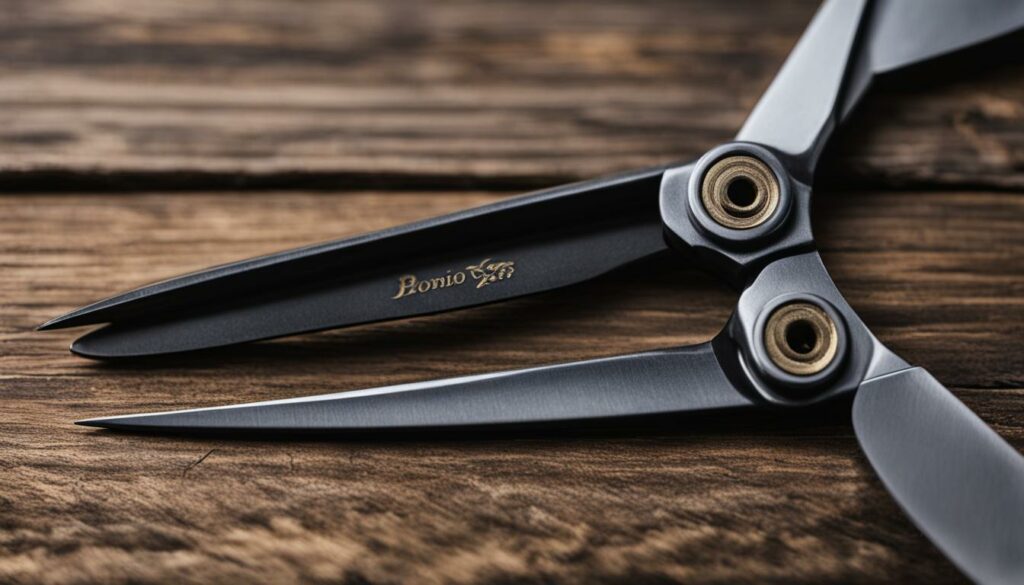
Correct usage of these scissors ensures flawless growth patterns and contributes to the overall health of your Bonsai. Whether you’re a novice enthusiast or an experienced collector, investing in the right grooming tools for Bonsai is as essential to Bonsai care as the sunlight that nourishes them. Remember, the right pair of Bonsai trimming scissors can make all the difference in the pursuit of creating a truly living work of art.
Resource Guide: Where to Find Quality Bonsai Equipment
As an enthusiast of the ancient art of Bonsai, you understand the importance of having not just any tools, but the right tools. Whether you are a beginner or a seasoned Bonsai artisan, knowing where to source quality Bonsai equipment is crucial for your practice. Below, you’ll find a comprehensive guide to help you navigate through Bonsai nurseries and online Bonsai stores, along with tips to ensure you’re getting the best value for your investment.
Local Bonsai Nurseries and Online Stores
Local Bonsai nurseries offer a hands-on approach to selecting your tools, where you can physically inspect each item for its craftsmanship and suitability. Experienced staff can provide personalized advice and insights into the tools that cater best to your Bonsai’s particular needs. On the flip side, online Bonsai stores offer a broader range of products and the convenience of home delivery. Renowned for their specialty in Bonsai supplies, these retailers have made quality Bonsai equipment accessible no matter where you are located.
Tips for Comparing Quality and Prices
When assessing Bonsai tools, it’s essential to strike a balance between quality and price. Keep an eye out for materials – high-carbon steel is most durable for cutting tools. Ergonomics also play a vital role, especially if you plan to spend hours caring for your Bonsai. Always read customer reviews and compare products across different platforms to ensure you’re getting a competitive price without compromising on quality.
| Criteria | Nurseries | Online Stores |
|---|---|---|
| Variety of Tools | Limited by space, Select | Extensive |
| Quality Assurance | Physical Inspection | Dependent on Brand Reputation |
| Price Comparison | Local Market Rates | Competitive, with deals |
| Expert Advice | Personalized Guidance | Online Reviews and Resources |
| Convenience | Immediate Purchase | Shop from Anywhere |
Remember, investing time into researching where to purchase your Bonsai tools will pay off with a well-equipped toolkit that lasts for years. Nurture your Bonsai with pride, knowing that the tools in your hands are sourced from the best Bonsai nurseries and online Bonsai stores around.
Conclusion
Throughout this journey, we’ve delved into the essential facets of successful Bonsai care, underscoring the pivotal role played by owning a comprehensive Bonsai tool kit. Each instrument serves a unique purpose – from pruning and shaping to watering and repotting – and they collectively form the backbone of meticulous Bonsai maintenance. We’ve explored how the thoughtful combination and use of these tools can significantly enhance the health and aesthetic appeal of your cherished Bonsai.
As you stand poised to either embark upon or continue your voyage through the artful realm of cultivating Bonsai, remember that the heart of Bonsai mastery lies in patience, finesse, and the correct application of your tools. It’s these tools that transform mere maintenance into an artistic expression, enabling you to create a living masterpiece that resonates with balance and harmony.
Armed with the knowledge of Bonsai care’s intricacies and equipped with tailor-made tools, you’re now ready to nurture these miniature trees with deeper understanding and refined skill. Embrace the serene challenge of Bonsai cultivation, and let your dedication to this ancient practice blossom into beautiful, living art.
FAQ
What are the essential tools I need for basic Bonsai care?
For basic Bonsai care, you should have a selection of pruning tools like concave cutters, shears, and wire cutters. Additionally, care tools like soil scoops, watering cans, and proper fertilizers are crucial for maintenance.
How does proper Bonsai equipment contribute to the art and science of Bonsai cultivation?
Proper Bonsai equipment respects the tradition’s meticulous nature and contributes to both the success and precision in Bonsai care. The right tools ensure the health and aesthetic appeal of the Bonsai by enabling precise pruning, appropriate soil management, and accurate watering.
What are some considerations when selecting the right Bonsai pot?
When selecting the right Bonsai pot, consider factors like size, shape, and material. The pot should complement the Bonsai’s design and be suitable for its growth requirements. Drainage, too, is an important aspect to ensure the tree’s health.
Why is pruning crucial in Bonsai care?
Pruning is crucial in Bonsai care because it shapes the tree, controls growth, and promotes healthy development. It helps in achieving the desired aesthetic and maintaining the miniature size of the Bonsai tree.
What tools are necessary for proper hydration of a Bonsai?
Precision tools such as watering cans and misters are essential for maintaining adequate moisture levels. Additionally, tools like moisture meters and hygrometers help in monitoring the water levels to prevent over or under-watering.
How do wiring techniques aid in shaping a Bonsai?
Wiring techniques help in training and shaping Bonsai branches, allowing you to manipulate the tree’s growth and create the desired form without harming the tree. Using the correct wiring methods is key to successful Bonsai shaping.
How can I ensure my Bonsai tools last a long time?
Ensure your Bonsai tools last by performing regular maintenance. This includes cleaning them after each use, sharpening cutting tools regularly, and storing them properly to prevent rust and damage.
What is the importance of fertilizer tools in Bonsai care?
Fertilizer tools aid in the effective application of fertilizers, ensuring that the Bonsai receives the nutrients it needs to thrive. They help in applying the correct amounts and avoiding waste or potential damage from over-fertilization.
How do pest and disease control tools work in safeguarding Bonsai health?
Pest and disease control tools such as sprayers and applicators deliver treatments precisely, helping to manage infestations or diseases without harming the plant. The choice of organic or synthetic treatment methods also plays a role in your approach to Bonsai care.
Where can I find quality Bonsai equipment?
Quality Bonsai equipment can be found at local Bonsai nurseries or specialized online stores. When comparing options, consider the retailer’s reputation, the quality of tools offered, and whether the prices are aligned with your budget and Bonsai care needs.
